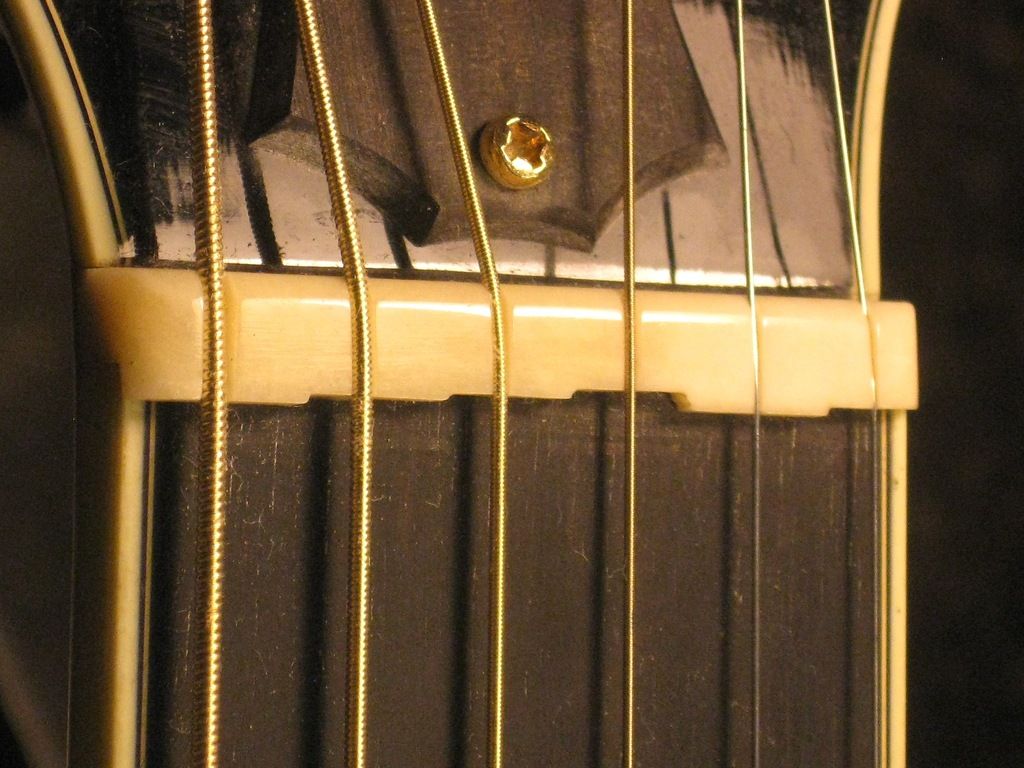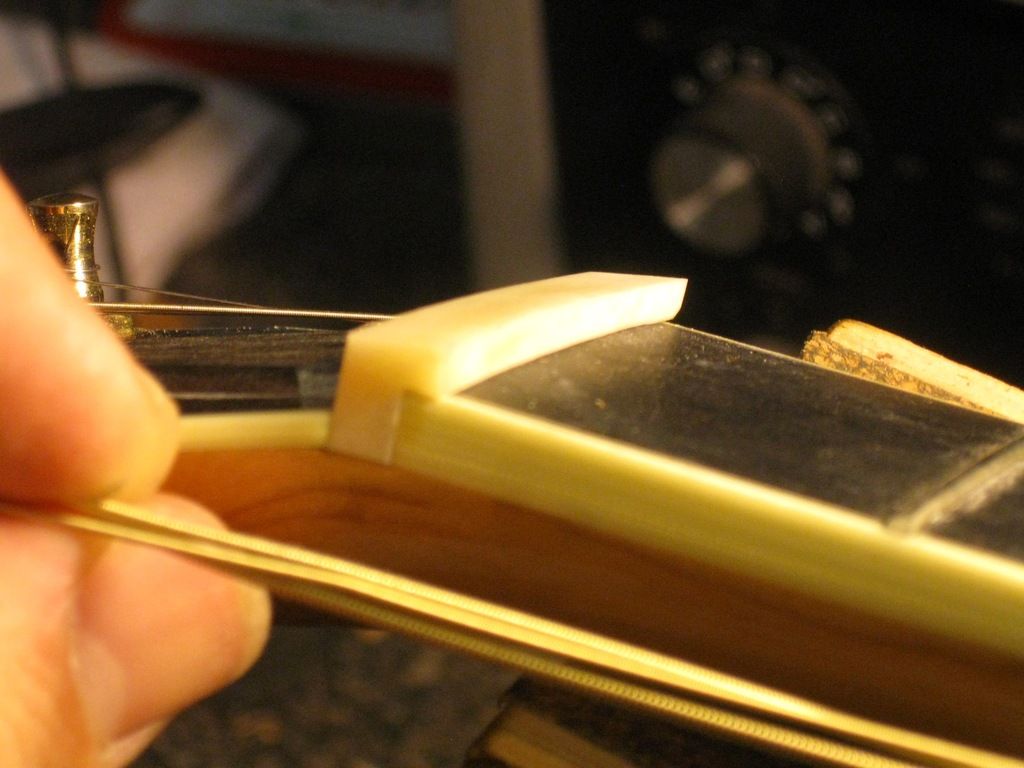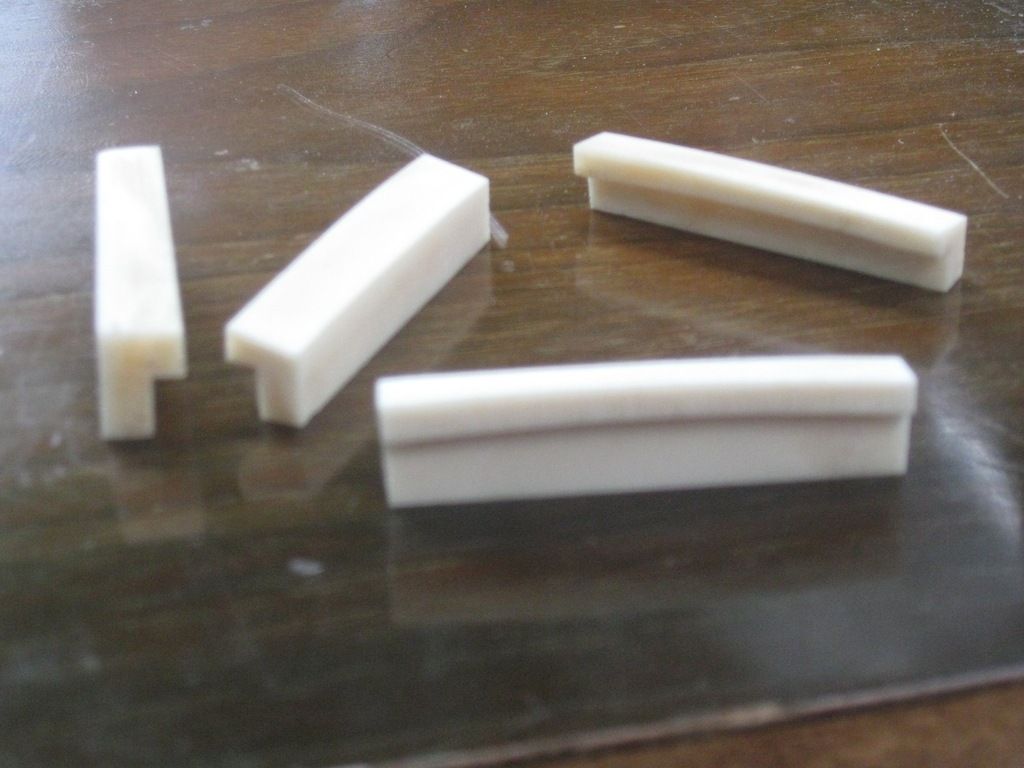
 |
|
#1
|
|||
|
|||
|
I am on eBay a lot, looking at guitars, parts and anything else guitar related. I've seen a brass nut that is compensated, and would like to know if this really improves intonation. Does it make enough difference to be worth it.
Sent from my XT1650 using Tapatalk Last edited by Kerbie; 03-18-2017 at 04:10 AM. Reason: Sp... |
|
#2
|
|||
|
|||
|
Can a compensated nut improve intonation? Yes, but it depends upon how it is implemented. One setting of compensation at the nut is no more accurate than one setting of compensation at the saddle.
If you want the best intonation you can get - regardless of saddle compensation and/or nut compensation - you'll need to have your guitar setup for your individual guitar, your chosen strings, your desired action and your playing style. It isn't as simple as just dropping in pre-fabricated parts and expecting them to yield the best intonation on any and every guitar. Will it be an improvement? Depends on the specifics of your instrument and setup. |
|
#3
|
|||
|
|||
|
Think of it this way. You need compensation to account for the increase in tension as a string is fretted. It's a compromise in all cases, for a lot of reasons, but some strings need more compensation than others. The B string needs a lot, and the low E string needs a lot, and the others a smaller and varying amount. You set up the bridge so the string plays in tune with itself when fretted at the 12th fret, and that is your compromise. But what about the open string? It's not fretted, there is no additional tension involved, so isn't it perfect? Yes, until you start to compare it to all the fretted notes, then it is a little off because there is no added tension to sharpen it up that tiny bit. So if you set up the bridge so that you are in tune with the string fretted at the first fret and the 13th fret, instead of open and 12th fret, and then move the nut a little bit to make the open string in tune with the fretted notes, you get a better compromise. Or so they say. If you can hear it, it's important to you. If you can't hear it (and it's legitimately in that window of discernibility by human hearing) then it doesn't matter to you. I have heard it on one guitar, but I didn't change the nut. I might later.
__________________
Brian Evans Around 15 archtops, electrics, resonators, a lap steel, a uke, a mandolin, some I made, some I bought, some kinda showed up and wouldn't leave. Tatamagouche Nova Scotia. |
|
#4
|
||||
|
||||
|
Seems to be an informative article here:
http://setitupbetter.com/Compensating-The-Nut.php
__________________
Derek Coombs Youtube -> Website -> Music -> Tabs Guitars by Mark Blanchard, Albert&Mueller, Paul Woolson, Collings, Composite Acoustics, and Derek Coombs "Reality is that which when you stop believing in it, doesn't go away." Woods hands pick by eye and ear
Made to one with pride and love To be that we hold so dear A voice from heavens above |
|
#5
|
|||
|
|||
|
Quote:
 . .Talk about backwards ... Last edited by Kerbie; 03-27-2017 at 11:26 AM. Reason: Removed masked profanity |
|
#6
|
|||
|
|||
|
For nut compensation to be an improvement, you need to move the saddle closer to the 12th fret as well. On a typical guitar, you might not be able to move the saddle points as far forward as they should be. So try the compensated nut together with a straight saddle (all the strings set as far forward as possible, no compensation ramps filed into it). Compare the 12th fret harmonic to the 12th fret note on each string. If the harmonic is lower than the fretted note, then shave some material off the saddle. If the harmonic is higher than the fretted note, shave some material off the nut.
|
|
#7
|
|||
|
|||
|
I don't have a lot of guitar building experience, but I do have a personal experience to share with you on this subject. I built a guitar last year, and I really wanted a compensated nut. To start, you either have to saw the end off of your fretboard or use a nut that overhangs the fretboard because the compensation is moving the nut towards the bridge. After trying 5 tuners and fooling with mine for hours, my conclusion is. For my intents and purposes, they are useless. When you pluck a string, it starts flat for a millisecond, then at the apex of the strike it is in tune, then as it decays it becomes flat again (assuming you are tuning to the attack) so by the time you figure that, and the fact that in order for a string to register the same note each time you have to hit it with exactly the same force and apply the exact same force with your fretting hand, it's just not feasable in the real world to achieve perfect intonation. People will say " I can get within +-2 cents all the way up and down the fretboard" That is not while they are playing an actual song. Then we come to tempered tuning and or just intonation ect. There is no way to build a guitar to be in tune to every key. All these factors come together and mean an intonated nut doesn't really help in the real world (my opinion based on attempting one for many hours)
__________________
disclaimer I don't know anything, everything I say is a guess, estimate, hearsay, or opinion. For your safety, don't assume anything I say is a fact. Research |
|
#8
|
|||
|
|||
|
I've been using nut compensation on my guitars for several years now, and at this point would not do it any other way. With proper nut and saddle compensation you can get all the notes on the guitar to be within a couple of cents (hundredths of a semitone) of where they 'should' be in pitch, which is 'way closer than any error you can hear. The trick is defining what pitch they 'should' be at.
On guitars that's usually going to be good old 12-tone Equal Temperament (or as some say 'Evil Temperament'). This has two big advantages: 1) the semitones are all the same size, which means that you can use straight frets, and, 2) you can modulate freely between keys since every major or minor key sounds 'the same'. The problem is that it's mathematically impossible to construct a scale that has 'perfect' (beatless) octaves and fifths for every interval. You can set one up for a single key, but as soon as you move to some other key it's worse, or even awful. Centuries of struggle back and forth lead to the widespread adoption of ET in Western music as an expedient, but nobody claims it's very good. It's just a reasonable compromise. There's no getting around the fact that some intervals in ET are pretty far 'out' from beatless perfection. In particular, thirds are quite bad. Under the circumstances, why bother trying to get it right? The short answer is that if you don't the interval that's a bit off in the key of D will likely be really off when you go to G or C. You can (and many people do) re-tune to 'sweeten' things, but that gets to be tedious, and makes it difficult to play along with other instruments. If you build that problem out then all you're left with the issue of learning to play carefully so that you don't make it any worse than it has to be. You'd need to do that anyway, so why not give yourself the break of having an instrument that plays as nearly 'in tune' as it can? |
|
#9
|
|||
|
|||
|
The way I see it, a compensated nut compensates for bad technique. If you play with proper technique, it's completely unnecessary.
I made this one for a customer who has a tendency to mash his chords out of tune: [IMG]  [/IMG] [/IMG]Here it is in the works: [IMG]  [/IMG] [/IMG]and here's a batch of blanks: [IMG]  [/IMG] [/IMG]
__________________
https://www.reverbnation.com/bootheelers |
|
#10
|
|||
|
|||
|
Some of the folks I've made compensated nuts for have excellent technique, and still find them worthwhile. They also have excellent ears....

|
|
#11
|
|||
|
|||
|
Quote:
Keep in mind that one of the ways that compensation at the nut can be applied is to simply foreshorten the fingerboard by a uniform amount, placing the nut slightly closer to the first fret. This is an easy thing to do and does improves intonation, though not as much as compensating each string individually. |
|
#12
|
|||
|
|||
|
Quote:
That is the only nut compensation I generally use. |
|
#13
|
|||
|
|||
|
Hot Vibrato - Nicely done
Steve
__________________
Cole Clark Fat Lady Gretsch Electromatic Martin CEO7 Maton Messiah Taylor 814CE |
|
#14
|
|||
|
|||
|
Quote:
However, in the last instrument I made, I used a little more than that and was quite happy with the result. |